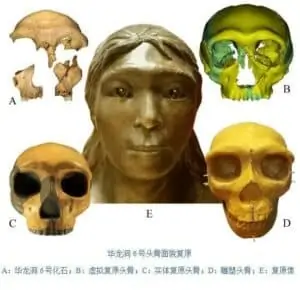化石測年證實了中國第一批現代人類 Fossils discovered in Hualong Cave (华龙 華龍 huálóng dòng) have now been dated and present a challenge to African origins
Africa has long been considered the birthplace of modern humans, sometimes referred to as Anatomically Modern Humans (AMHs). Three sites in particular have been identified as the most likely spots for the emergence of AMHs: Jebel Irhoud in Morocco and, Omo and Herto in Ethiopia.
長期以來,非洲一直被認為是現代人類的發源地,有時也被稱為解剖學上的現代人類 (AMH)。 特別是兩個地點被確定為最有可能出現 AMH 的地點:摩洛哥的 Jebel Irhoud 和埃塞俄比亞的 Herto.
From a paper published in Nature, 2017,
New fossils from Jebel Irhoud, Morocco and the pan-African origin of Homo sapiens
Fossil evidence points to an African origin of Homo sapiens from a group called either H. heidelbergensis or H. rhodesiensis. However, the exact place and time of emergence of H. sapiens remain obscure because the fossil record is scarce and the chronological age of many key specimens remains uncertain.
Here we report newly discovered human fossils from Jebel Irhoud, Morocco, and interpret the affinities of the hominins from this site with other archaic and recent human groups. We identified a mosaic of features including facial, mandibular and dental morphology that aligns the Jebel Irhoud material with early or recent anatomically modern humans and more primitive neurocranial and endocranial morphology… it shows that the evolutionary processes behind the emergence of H. sapiens involved the whole African continent.
化石證據表明智人起源於非洲,來自一個稱為海德堡人或羅得西人的群體。 然而,智人出現的確切地點和時間仍不清楚,因為化石記錄稀少,而且許多關鍵標本的年代仍不確定。
在這裡,我們報告了來自摩洛哥傑貝爾伊魯德的新發現的人類化石,並解釋了來自該地點的古人類與其他古代和近代人類群體的親緣關係。 我們確定了包括面部、下頜和牙齒形態在內的一系列特徵,這些特徵將 Jebel Irhoud 材料與早期或最近的解剖學現代人類以及更原始的神經顱骨和顱內形態對齊……這表明智人出現背後的進化過程涉及 整個非洲大陸。
From the Smithsonian Magazine 2012:
 Paleoanthropologists agree that modern humans evolved in Africa about 200,000 years ago… At this time, many of the fossils thought to be early members of our species possess a mix of modern and primitive traits.
Paleoanthropologists agree that modern humans evolved in Africa about 200,000 years ago… At this time, many of the fossils thought to be early members of our species possess a mix of modern and primitive traits.
In 1967, a team led by Richard Leakey discovered possible Homo sapiens fossils in the Kibish Formation near the Omo River in southern Ethiopia. Originally the fossils, Omo I (a partial skull and skeleton) and Omo II (a partial skull)… a dating reanalysis in 2005 revealed they were much older—195,000 years old… Researchers largely agree Omo I was a modern human; it had the human hallmarks of a flat face, fully formed chin, high forehead and globular braincase.
古人類學家一致認為,現代人類大約在 20 萬年前在非洲進化……此時,許多被認為是我們物種早期成員的化石具有現代和原始特徵的混合。
1967 年,由理查德·利基 (Richard Leakey) 領導的一個團隊在埃塞俄比亞南部奧莫河附近的基比什組 (Kibish Formation) 中發現了可能的智人化石。 最初的化石,Omo I(部分頭骨和骨架)和 Omo II(部分頭骨)…… 2005 年的約會再分析顯示它們的年齡要大得多——195,000 歲……研究人員基本上同意 Omo I 是現代人 ; 它具有平坦的臉龐、完整的下巴、高高的前額和球形腦殼等人類特徵。
Addtionally:
Herto fossils (160,000 years ago): Tim White of the University of California at Berkeley and colleagues unearthed three largely complete skulls, two adults and one child, in the Middle Awash region of Ethiopia in 1997. The skulls appear quite modern…
Herto 化石(160,000 年前):加州大學伯克利分校的 Tim White 及其同事於 1997 年在埃塞俄比亞的 Middle Awash 地區出土了三個基本完整的頭骨,兩個成人和一個兒童。這些頭骨看起來非常現代……
Facial morphology… HLD6 measurements… weak prognathism, flat face and features in nasal… suggests that the hominin population to which HLD 6 belonged may represent the earliest pre-modern humans in East Asia.
On October 8, Bio-geneticist Dr. Shi Huang, a favorite of this website, announced the find to the world via Twitter:
Chinese scholars discovered and restored the earliest human fossils with modern facial features in East Asia
我国学者发现东亚最早具有现代人面部特征的人类化石并复原面貌
Dr. Huang added:
[The] modern features in Hualongdong Skull (~300000 year old) obviously could not have anything to do with any migrants from Africa.
華龍洞頭骨(約 30 萬年前)的現代特徵顯然與任何來自非洲的移民沒有任何關係。
Odyssey to the Far East, authors of the alt-anthropology site, motherlander.wordpres.com, Tweeted out:
 The research team restored the face of the Hualongdong human, showing the appearance of 300,000-year-old humans from Hualong Cave ivpp.cas.cn/xwdt/kyjz/2021 most facial features are located in the range of early and extant modern humans
The research team restored the face of the Hualongdong human, showing the appearance of 300,000-year-old humans from Hualong Cave ivpp.cas.cn/xwdt/kyjz/2021 most facial features are located in the range of early and extant modern humans
研究團隊還原了化龍洞人的面部,展示了化龍洞30萬年前人類的樣貌 http://ivpp.cas.cn/xwdt/kyjz/202110/t20211008_6219503.html……大部分面部特徵位於 早期和現存現代人類的範圍
A pre-print has since been released in the Journal of Human Evolution, dated December 2021. The authors include: XiujieWu, ShuwenPei, YanjunCai, HaowenTong, SongXing, Tea Jashashvili, Kristian J.Carlson, WuLiu.
Lead author Xiujie Wu is best known to American audiences as Chair of the Institute of Vertebrate Paleontology and Paleoanthropology, Chinese Academy of Sciences.
此後發布了預印本,日期為 2021 年 12 月。 作者包括:XuijieWu, ShuwenPei, YanjunCai, HaowenTong, SongXing, Tea Jashashvili, Kristian J.Carlson, WuLiu.
主要作者吳修傑是中國科學院古脊椎動物與古人類研究所所長,為美國觀眾所熟知。
Some highlights (重要的筆記),
Morphological description and evolutionary significance of 300 ka hominin facial bones from Hualongdong, China
Late Middle Pleistocene hominins in Africa displaying key modern morphologies by 315 ka are claimed as the earliest Homo sapiens.. Newly discovered 300 ka hominin fossils from Hualongdong, China, provide further evidence to clarify these relationships in the region. In this study, facial morphology of the juvenile partial cranium (HLD 6) is described and qualitatively and quantitatively compared with that of other key Early, Middle, and Late Pleistocene hominins from East Asia, Africa, West Asia, and Europe…
Qualitatively, facial morphology of HLD 6 resembles that of Early and Middle Pleistocene hominins from Zhoukoudian, Nanjing, Dali, and Jinniushan in China, as well as others from Java, Africa, and Europe in some of these features (e.g., supraorbital and malar regions), and Late Pleistocene hominins and modern humans from East Asia, Africa, and Europe in other features (e.g., weak prognathism, flat face and features in nasal and hard plate regions).
Comparisons of HLD 6 measurements to group means and multivariate analyses support close affinities of HLD 6 to Late Pleistocene hominins and modern humans… Thus, the transition from archaic to modern morphology in East Asian hominins may have occurred at least by 300 ka, which is 80,000 to 100,000 years earlier than previously recognized.
非洲中更新世晚期顯示出關鍵現代形態 315 ka 的古人類被認為是最早的智人。在中國化龍洞新發現的 300 ka 古人類化石為闡明該地區的這些關係提供了進一步的證據。在這項研究中,描述了幼年部分顱骨 (HLD 6) 的面部形態,並與來自東亞、非洲、西亞和歐洲的其他早、中、晚更新世關鍵人類的面部形態進行了定性和定量的比較。
定性地,HLD 6 的面部形態類似於中國周口店、南京、大理和金牛山的早中更新世人類,以及爪哇、非洲和歐洲的其他一些特徵(例如,眶上和顴骨區域) ),以及來自東亞、非洲和歐洲的晚更新世古人類和現代人類的其他特徵(例如弱前突、扁平臉以及鼻和硬板區域的特徵)。
HLD 6 測量值與組均值和多變量分析的比較支持 HLD 6 與晚更新世人類和現代人類的密切關係……因此,東亞人類從古代到現代形態的轉變可能至少發生在 300 ka,即比以前認為的早 80,000 到 100,000 年。
Of course, a dating of ~300 ka puts HLD 6 in direct competition with Jebel Irhoud, Omo 1 and Herto as the earliest identified Anatomically Modern Human, and presents a great challenge to purely African origins.
當然,約 300 ka 的約會使 HLD 6 與 Jebel Irhoud、Omo 1 和 Herto 作為最早確定的解剖學現代人類直接競爭,並對純非洲血統提出了巨大挑戰。
Editor’s Note – Mandarin Chinese translation Eric Dondero, intermediate level Mandarin speaker, with review and edits by native Mandarin speaker Shandra Li.



